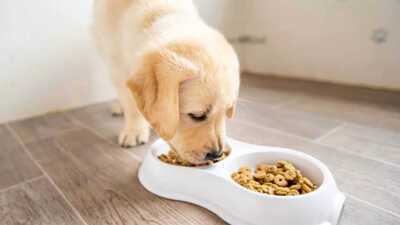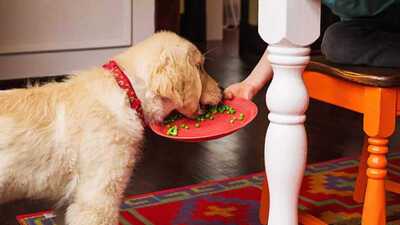Dogs are one of the best furry friends one could ever have. From unlimited cuddles to naughty mischiefs, dogs share various memorable moments with their pawrents and make their life with their companionship.
However, one of the most concerning aspects of having these furry family members is their diet, which directly affects their health. Pet parents frequently ask veterinary doctors about the ideal diet for their dogs and how much they should feed them daily. We have the answer below!
Why is it important to feed a dog properly?
Food is the primary source of nutrition for dogs and correlates to their health and energy levels. Underfeeding them can lead to health deterioration, low energy levels, poor immune function and more.
However, overfeeding them also has its cons. As per the Association for Pet Obesity Preventions, about 59% of dogs are overweight or obese, putting them at risk of joint diseases, heart problems, shortened lifespan, some forms of cancer and more.
Factors that affect a dog's daily diet

There are a variety of factors that affect your dog's daily diet. These include age, size, breed, energy level, the type of food they eat, their reproductive status and more. Ideally, it is advised to feed a dog between 2-3% of their body weight, which one can split into two or three meals a day.
Weight: Maintaining the ideal body weight is important for the dog's overall health. “If your dog is not in his ideal body condition, you may need to make adjustments in what and how much you are feeding him,” said Dr Callie Harris, DVM, to Purina.com.
Age: Puppies need more energy in the form of calories, protein and vitamins as compared to adult dogs; they need more balanced food.
Activity levels: When feeding from packages, the food quantities are suggested for average adult dogs with normal activity levels. However, if your dog gets a lot of daily walks and exercise, they may need more energy and thus more food. “Dogs who are less active and overweight may need a more managed daily caloric intake,” according to Harris.
Reproductive status: Dogs that have been spayed and neutered need fewer calories than those that are not or those who are pregnant. They need more daily meals.
Breeds: A dog's daily diet differs on the basis of their breed as well. Large and giant breeds need two to three meals per day, small and medium breeds need two meals per day, and toy breeds need three to five meals per day.
How much to feed a dog in a day?

Most dog food packaging contains their own dog feeding charts, but these can vary from brand to brand. “Dog feeding charts usually make recommendations for daily intake. So, if you’re feeding your dog more than once a day, you’ll need to divide the amount recommended in the chart between those meals,” said Harris.
A basic dog feeding chart you can follow:
Adult Dog Size (lbs) Dry Food Feeding Amount (cups)
3 to 12 1/3 to 1
13 to 20 1 to 1/3
21 to 35 1-1/3 to 2
26 to 50 2 to 2-2/3
51 to 75 2-2/3 to 3-1/3
76 to 100 3-1/3 to 4-1/4
100+ 4-1/4 plus 1/4 cup for each 10 lbs of body weight
A normal feeding amount to follow is twice a day, once in the morning, once at night. This is because after feeding them once, their stomach gets empty within a few hours as the food moves to the small intestine. Thus, after 8-10 hours, the stomach begins sending signals of hunger to the brain, demanding a second meal. But it is ideal to consult a veterinarian before increasing or decreasing this amount.
Disclaimer: The information provided in this article is for general informational purposes only and does not substitute professional veterinary advice.
However, one of the most concerning aspects of having these furry family members is their diet, which directly affects their health. Pet parents frequently ask veterinary doctors about the ideal diet for their dogs and how much they should feed them daily. We have the answer below!
Why is it important to feed a dog properly?

Food is the primary source of nutrition for dogs and correlates to their health and energy levels. Underfeeding them can lead to health deterioration, low energy levels, poor immune function and more.
However, overfeeding them also has its cons. As per the Association for Pet Obesity Preventions, about 59% of dogs are overweight or obese, putting them at risk of joint diseases, heart problems, shortened lifespan, some forms of cancer and more.
Factors that affect a dog's daily diet
There are a variety of factors that affect your dog's daily diet. These include age, size, breed, energy level, the type of food they eat, their reproductive status and more. Ideally, it is advised to feed a dog between 2-3% of their body weight, which one can split into two or three meals a day.
Weight: Maintaining the ideal body weight is important for the dog's overall health. “If your dog is not in his ideal body condition, you may need to make adjustments in what and how much you are feeding him,” said Dr Callie Harris, DVM, to Purina.com.
Age: Puppies need more energy in the form of calories, protein and vitamins as compared to adult dogs; they need more balanced food.
Activity levels: When feeding from packages, the food quantities are suggested for average adult dogs with normal activity levels. However, if your dog gets a lot of daily walks and exercise, they may need more energy and thus more food. “Dogs who are less active and overweight may need a more managed daily caloric intake,” according to Harris.
Reproductive status: Dogs that have been spayed and neutered need fewer calories than those that are not or those who are pregnant. They need more daily meals.
Breeds: A dog's daily diet differs on the basis of their breed as well. Large and giant breeds need two to three meals per day, small and medium breeds need two meals per day, and toy breeds need three to five meals per day.
How much to feed a dog in a day?
Most dog food packaging contains their own dog feeding charts, but these can vary from brand to brand. “Dog feeding charts usually make recommendations for daily intake. So, if you’re feeding your dog more than once a day, you’ll need to divide the amount recommended in the chart between those meals,” said Harris.
A basic dog feeding chart you can follow:
Adult Dog Size (lbs) Dry Food Feeding Amount (cups)
3 to 12 1/3 to 1
13 to 20 1 to 1/3
21 to 35 1-1/3 to 2
26 to 50 2 to 2-2/3
51 to 75 2-2/3 to 3-1/3
76 to 100 3-1/3 to 4-1/4
100+ 4-1/4 plus 1/4 cup for each 10 lbs of body weight
A normal feeding amount to follow is twice a day, once in the morning, once at night. This is because after feeding them once, their stomach gets empty within a few hours as the food moves to the small intestine. Thus, after 8-10 hours, the stomach begins sending signals of hunger to the brain, demanding a second meal. But it is ideal to consult a veterinarian before increasing or decreasing this amount.
Disclaimer: The information provided in this article is for general informational purposes only and does not substitute professional veterinary advice.
You may also like

Sudan's paramilitary-led coalition announces formation of parallel govt

Dunelm's 'really pretty' floral bedding 'washes well' and is 'easy to iron

PM Modi to address nation through 'Mann Ki Baat' today

'I'm a travel agent – here's the £1.50 item I tell holidaymakers to always pack'

"We are going to have very bright future": Ex Maldives President on relations with India





